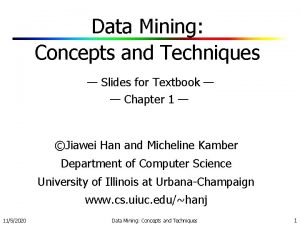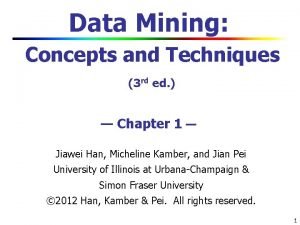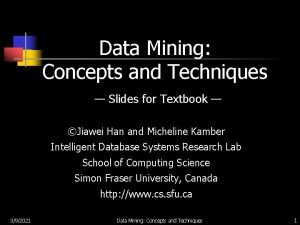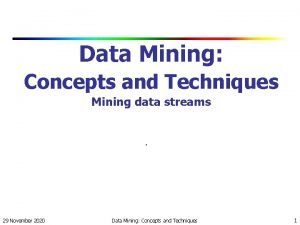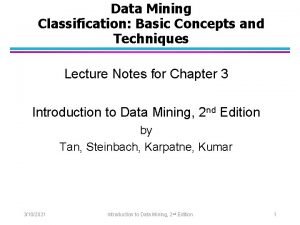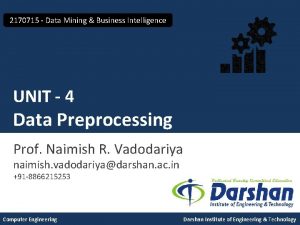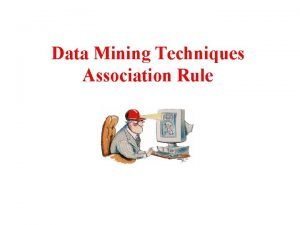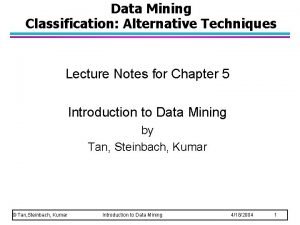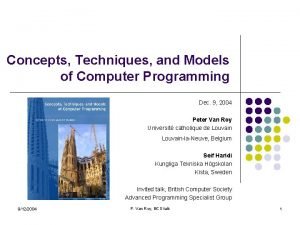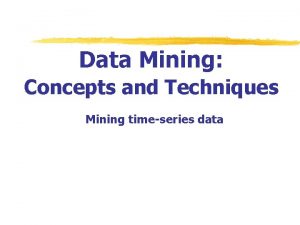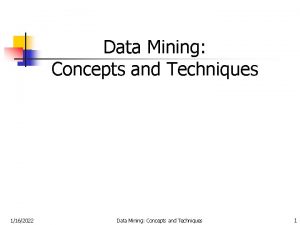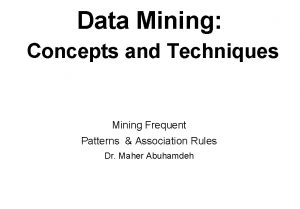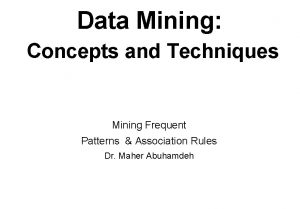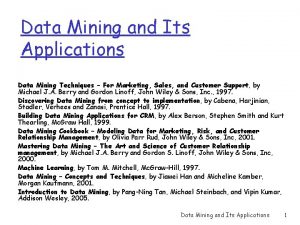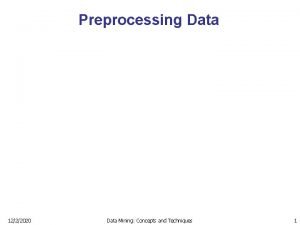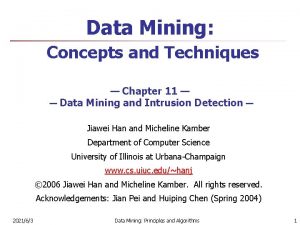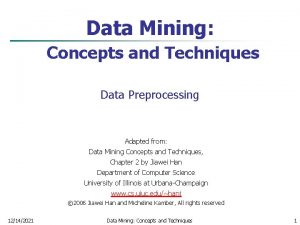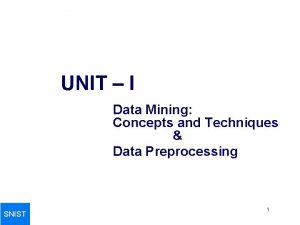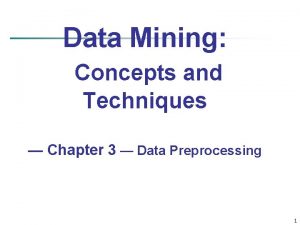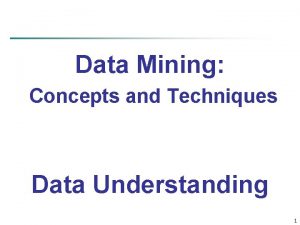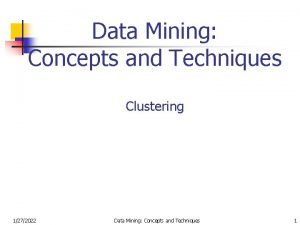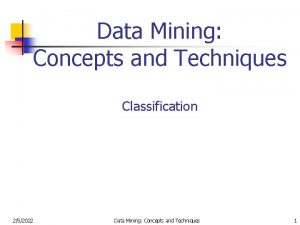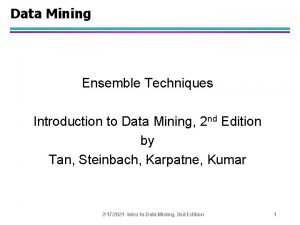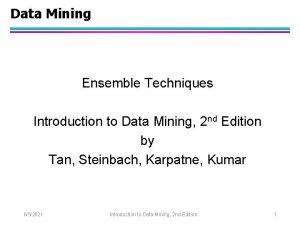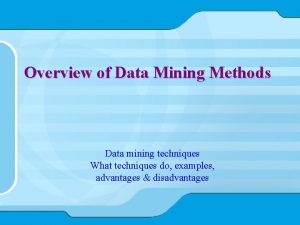Data Mining Concepts and Techniques 9182020 Data Mining





































- Slides: 37

Data Mining: Concepts and Techniques 9/18/2020 Data Mining: Concepts and Techniques 1

Chapter 1. Introduction n Motivation: Why data mining? n What is data mining? n Data Mining: On what kind of data? n Data mining functionality n Are all the patterns interesting? n Major issues in data mining 9/18/2020 Data Mining: Concepts and Techniques 2

Motivation: “Necessity is the Mother of Invention” n Data explosion problem n Automated data collection tools and mature database technology lead to tremendous amounts of data stored in databases, data warehouses and other information repositories n We are drowning in data, but starving for knowledge! n Solution: Data warehousing and data mining n Data warehousing and on-line analytical processing n Extraction of interesting knowledge (rules, regularities, patterns, constraints) from data in large databases 9/18/2020 Data Mining: Concepts and Techniques 3

Evolution of Database Technology n 1960 s: n n 1970 s: n n RDBMS, advanced data models (extended-relational, OO, deductive, etc. ) and application-oriented DBMS (spatial, scientific, engineering, etc. ) 1990 s— 2000 s: n 9/18/2020 Relational data model, relational DBMS implementation 1980 s: n n Data collection, database creation, IMS and network DBMS Data mining and data warehousing, multimedia databases, and Web databases Data Mining: Concepts and Techniques 4

What Is Data Mining? n Data mining (knowledge discovery in databases): n n Alternative names: n n n Data mining: a misnomer? Knowledge discovery(mining) in databases (KDD), knowledge extraction, data/pattern analysis, data archeology, data dredging, information harvesting, business intelligence, etc. What is not data mining? n n 9/18/2020 Extraction of interesting (non-trivial, implicit, previously unknown and potentially useful) information or patterns from data in large databases (Deductive) query processing. Expert systems or small ML/statistical programs Data Mining: Concepts and Techniques 5

Why Data Mining? — Potential Applications n Database analysis and decision support n Market analysis and management n n Risk analysis and management n n n target marketing, customer relation management, market basket analysis, cross selling, market segmentation Forecasting, customer retention, improved underwriting, quality control, competitive analysis Fraud detection and management Other Applications n n 9/18/2020 Text mining (news group, email, documents) Stream data mining Web mining. DNA data analysis Data Mining: Concepts and Techniques 6

Market Analysis and Management (1) n Where are the data sources for analysis? n n Target marketing n n 9/18/2020 Find clusters of “model” customers who share the same characteristics: interest, income level, spending habits, etc. Determine customer purchasing patterns over time n n Credit card transactions, loyalty cards, discount coupons, customer complaint calls, plus (public) lifestyle studies Conversion of single to a joint bank account: marriage, etc. Cross-market analysis n Associations/co-relations between product sales n Prediction based on the association information Data Mining: Concepts and Techniques 7

Market Analysis and Management (2) n Customer profiling n data mining can tell you what types of customers buy what products (clustering or classification) n n Identifying customer requirements n identifying the best products for different customers n use prediction to find what factors will attract new customers Provides summary information n various multidimensional summary reports n statistical summary information (data central tendency and variation) 9/18/2020 Data Mining: Concepts and Techniques 8

Corporate Analysis and Risk Management n Finance planning and asset evaluation n n Resource planning: n n cash flow analysis and prediction contingent claim analysis to evaluate assets cross-sectional and time series analysis (financial-ratio, trend analysis, etc. ) summarize and compare the resources and spending Competition: n n n 9/18/2020 monitor competitors and market directions group customers into classes and a class-based pricing procedure set pricing strategy in a highly competitive market Data Mining: Concepts and Techniques 9

Fraud Detection and Management (1) n Applications n n Approach n n use historical data to build models of fraudulent behavior and use data mining to help identify similar instances Examples n n n 9/18/2020 widely used in health care, retail, credit card services, telecommunications (phone card fraud), etc. auto insurance: detect a group of people who stage accidents to collect on insurance money laundering: detect suspicious money transactions (US Treasury's Financial Crimes Enforcement Network) medical insurance: detect professional patients and ring of doctors and ring of references Data Mining: Concepts and Techniques 10

Fraud Detection and Management (2) n Detecting inappropriate medical treatment n n Detecting telephone fraud n n n Telephone call model: destination of the call, duration, time of day or week. Analyze patterns that deviate from an expected norm. British Telecom identified discrete groups of callers with frequent intra-group calls, especially mobile phones, and broke a multimillion dollar fraud. Retail n 9/18/2020 Australian Health Insurance Commission identifies that in many cases blanket screening tests were requested (save Australian $1 m/yr). Analysts estimate that 38% of retail shrink is due to dishonest employees. Data Mining: Concepts and Techniques 11

Other Applications n Sports n n Astronomy n n JPL and the Palomar Observatory discovered 22 quasars with the help of data mining Internet Web Surf-Aid n 9/18/2020 IBM Advanced Scout analyzed NBA game statistics (shots blocked, assists, and fouls) to gain competitive advantage for New York Knicks and Miami Heat IBM Surf-Aid applies data mining algorithms to Web access logs for market-related pages to discover customer preference and behavior pages, analyzing effectiveness of Web marketing, improving Web site organization, etc. Data Mining: Concepts and Techniques 12

Data Mining: A KDD Process Pattern Evaluation n Data mining: the core of knowledge discovery Data Mining process. Task-relevant Data Warehouse Selection Data Cleaning Data Integration Databases 9/18/2020 Data Mining: Concepts and Techniques 13

Steps of a KDD Process n Learning the application domain: n n Creating a target data set: data selection Data cleaning and preprocessing: (may take 60% of effort!) Data reduction and transformation: n n 9/18/2020 summarization, classification, regression, association, clustering. Choosing the mining algorithm(s) Data mining: search for patterns of interest Pattern evaluation and knowledge presentation n n Find useful features, dimensionality/variable reduction, invariant representation. Choosing functions of data mining n n relevant prior knowledge and goals of application visualization, transformation, removing redundant patterns, etc. Use of discovered knowledge Data Mining: Concepts and Techniques 14

Data Mining and Business Intelligence Increasing potential to support business decisions Making Decisions Data Presentation Visualization Techniques Data Mining Information Discovery End User Business Analyst Data Exploration Statistical Analysis, Querying and Reporting Data Warehouses / Data Marts OLAP, MDA Data Sources Paper, Files, Information Providers, Database Systems, OLTP 9/18/2020 Data Mining: Concepts and Techniques DBA 15

Architecture of a Typical Data Mining System Graphical user interface Pattern evaluation Data mining engine Database or data warehouse server Data cleaning & data integration Databases 9/18/2020 Knowledge-base Filtering Data Warehouse Data Mining: Concepts and Techniques 16

Data Mining: On What Kind of Data? n n Relational databases Data warehouses Transactional databases Advanced DB and information repositories n n n 9/18/2020 Object-oriented and object-relational databases Spatial and temporal data Time-series data and stream data Text databases and multimedia databases Heterogeneous and legacy databases WWW Data Mining: Concepts and Techniques 17

Data Mining Functionalities 9/18/2020 Data Mining: Concepts and Techniques 18

Concept description: Characterization and discrimination Initial Relation Prime Generalized Relation

Association Rule Mining n Association rule mining: n n n Finding frequent patterns, associations, correlations, or causal structures among sets of items or objects in transaction databases, relational databases, and other information repositories. Frequent pattern: pattern (set of items, sequence, etc. ) that occurs frequently in a database Motivation: finding regularities in data n n 9/18/2020 What products were often purchased together? — Beer and diapers? ! What are the subsequent purchases after buying a PC? What kinds of DNA are sensitive to this new drug? Can we automatically classify web documents? Data Mining: Concepts and Techniques 20

Association Rule Mining (cont. ) Transaction-id 10 20 30 40 Customer buys both Customer buys beer 9/18/2020 Items bought A, B, C A, D B, E, F Customer buys diapers n n Itemset X={x 1, …, xk} Find all the rules X Y with min confidence and support n support, s, probability that a transaction contains X Y n confidence, c, conditional probability that a transaction having X also contains Y. Let min_support = 50%, min_conf = 50%: A C (50%, 66. 7%) C A (50%, 100%) Data Mining: Concepts and Techniques 21

Visualization of Association Rules 9/18/2020 Data Mining: Concepts and Techniques 22

Classification and Prediction n n 9/18/2020 Finding models (functions) that describe and distinguish classes or concepts for future prediction E. g. , classify countries based on climate, or classify cars based on gas mileage Presentation: decision-tree, classification rule, neural network Prediction: Predict some unknown or missing numerical values Data Mining: Concepts and Techniques 23

Classification Process: Model Construction Classification Algorithms Training Data Classifier (Model) IF rank = ‘professor’ OR years > 6 THEN tenured = ‘yes’ 9/18/2020 Data Mining: Concepts and Techniques 24

Classification Process: Use the Model in Prediction Classifier Testing Data Unseen Data (Jeff, Professor, 4) Tenured? 9/18/2020 Data Mining: Concepts and Techniques 25

Decision Trees Training set 9/18/2020 Data Mining: Concepts and Techniques 26

Output: A Decision Tree for “buys_computer” age? <=30 student? 9/18/2020 overcast 30. . 40 yes >40 credit rating? no yes excellent fair no yes Data Mining: Concepts and Techniques 27

Presentation of Classification Results 9/18/2020 Data Mining: Concepts and Techniques 28

Cluster and outlier analysis n Cluster analysis n n n Class label is unknown: Group data to form new classes, e. g. , cluster houses to find distribution patterns Clustering based on the principle: maximizing the intra-class similarity and minimizing the interclass similarity Outlier analysis n Outlier: a data object that does not comply with the general behavior of the data n It can be considered as noise or exception but is quite useful in fraud detection, rare events analysis 9/18/2020 Data Mining: Concepts and Techniques 29

Clusters and Outliers 9/18/2020 Data Mining: Concepts and Techniques 30

Non-Traditional Mining Techniques Web Mining Web Content Mining w Text-based search Web Structure Mining Web Usage Mining w Google engines 9/18/2020 Data Mining: Concepts and Techniques 31

Are All the “Discovered” Patterns Interesting? n A data mining system/query may generate thousands of patterns, not all of them are interesting. n n Suggested approach: Human-centered, query-based, focused mining Interestingness measures: A pattern is interesting if it is easily understood by humans, valid on new or test data with some degree of certainty, potentially useful, novel, or validates some hypothesis that a user seeks to confirm n Objective vs. subjective interestingness measures: n Objective: based on statistics and structures of patterns, e. g. , support, confidence, etc. n Subjective: based on user’s belief in the data, e. g. , unexpectedness, novelty, actionability, etc. 9/18/2020 Data Mining: Concepts and Techniques 32

Data Mining: Confluence of Multiple Disciplines Database Technology Machine Learning Information Science 9/18/2020 Statistics Data Mining Visualization Other Disciplines Data Mining: Concepts and Techniques 33

Major Issues in Data Mining (1) n n Mining methodology and user interaction n Mining different kinds of knowledge in databases n Interactive mining of knowledge at multiple levels of abstraction n Incorporation of background knowledge n Data mining query languages and ad-hoc data mining n Expression and visualization of data mining results n Handling noise and incomplete data n Pattern evaluation: the interestingness problem Performance and scalability n Efficiency and scalability of data mining algorithms n Parallel, distributed and incremental mining methods 9/18/2020 Data Mining: Concepts and Techniques 34

Major Issues in Data Mining (2) n Issues relating to the diversity of data types n n n Handling relational and complex types of data Mining information from heterogeneous databases and global information systems (WWW) Issues related to applications and social impacts n n n 9/18/2020 Application of discovered knowledge n Domain-specific data mining tools n Intelligent query answering n Process control and decision making Integration of the discovered knowledge with existing knowledge: A knowledge fusion problem Protection of data security, integrity, and privacy Data Mining: Concepts and Techniques 35

Summary n n n Data mining: discovering interesting patterns from large amounts of data A natural evolution of database technology, in great demand, with wide applications A KDD process includes data cleaning, data integration, data selection, transformation, data mining, pattern evaluation, and knowledge presentation Mining can be performed in a variety of information repositories Data mining functionalities: characterization, discrimination, association, classification, clustering, outlier and trend analysis, etc. n Classification of data mining systems n Major issues in data mining 9/18/2020 Data Mining: Concepts and Techniques 36

A Brief History of Data Mining Society n 1989 IJCAI Workshop on Knowledge Discovery in Databases (Piatetsky -Shapiro) n n 1991 -1994 Workshops on Knowledge Discovery in Databases n n n Advances in Knowledge Discovery and Data Mining (U. Fayyad, G. Piatetsky. Shapiro, P. Smyth, and R. Uthurusamy, 1996) 1995 -1998 International Conferences on Knowledge Discovery in Databases and Data Mining (KDD’ 95 -98) n n Knowledge Discovery in Databases (G. Piatetsky-Shapiro and W. Frawley, 1991) Journal of Data Mining and Knowledge Discovery (1997) 1998 ACM SIGKDD, SIGKDD’ 1999 -2001 conferences, and SIGKDD Explorations More conferences on data mining n 9/18/2020 PAKDD, PKDD, SIAM-Data Mining, (IEEE) ICDM, etc. Data Mining: Concepts and Techniques 37
 Data mining concepts and techniques
Data mining concepts and techniques Function of data mining
Function of data mining Data mining slides
Data mining slides Data mining concepts and techniques slides
Data mining concepts and techniques slides Mining complex data types
Mining complex data types Basic concepts in mining data streams
Basic concepts in mining data streams Basic concepts of classification in data mining
Basic concepts of classification in data mining Mining multimedia databases in data mining
Mining multimedia databases in data mining Binning method in data mining
Binning method in data mining Association data mining techniques
Association data mining techniques Classification alternative techniques in data mining
Classification alternative techniques in data mining Difference between strip mining and open pit mining
Difference between strip mining and open pit mining Text and web mining
Text and web mining Concepts, techniques and models of computer programming
Concepts, techniques and models of computer programming Strip mining vs open pit mining
Strip mining vs open pit mining Chapter 13 mineral resources and mining
Chapter 13 mineral resources and mining What is kdd process in data mining
What is kdd process in data mining Crm data warehouse models
Crm data warehouse models Olap data warehouse
Olap data warehouse Introduction to data warehousing and data mining
Introduction to data warehousing and data mining Dfd chapter 5
Dfd chapter 5 Dfd chapter 5
Dfd chapter 5 Les fonctions techniques et les solutions techniques
Les fonctions techniques et les solutions techniques Data reduction in data mining
Data reduction in data mining What is missing data in data mining
What is missing data in data mining Concept hierarchy generation for nominal data
Concept hierarchy generation for nominal data Data reduction in data mining
Data reduction in data mining Data reduction in data mining
Data reduction in data mining Shell cube in data mining
Shell cube in data mining Data reduction in data mining
Data reduction in data mining Arsitektur data mining
Arsitektur data mining Perbedaan data warehouse dan data mining
Perbedaan data warehouse dan data mining Descriptive mining of complex data objects
Descriptive mining of complex data objects Noisy data in data mining
Noisy data in data mining 3 tier architecture of data warehouse
3 tier architecture of data warehouse Markku roiha
Markku roiha Data compression in data mining
Data compression in data mining Data warehouse dan data mining
Data warehouse dan data mining
